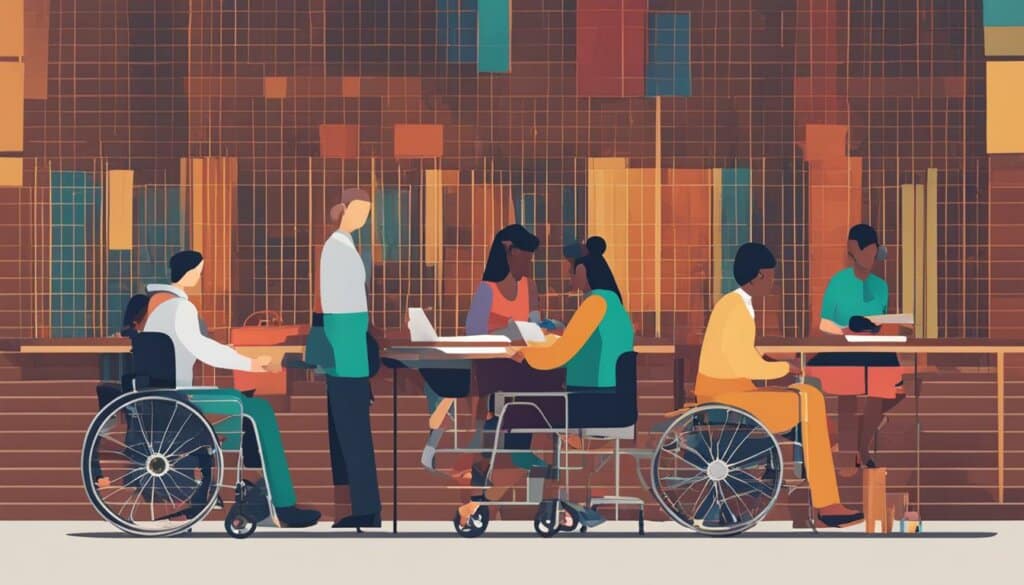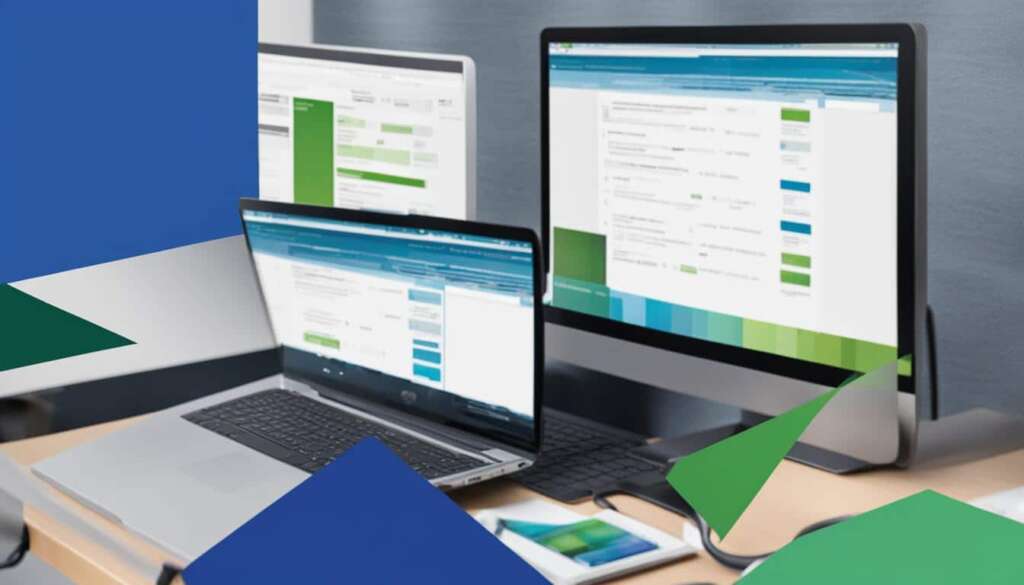Table of Contents
Web and software design play a crucial role in ensuring accessibility for all users. Accessibility is the key to providing a seamless user experience, adhering to compliance standards, and promoting inclusivity in digital spaces.
When websites and applications are designed with accessibility in mind, they become accessible to people with disabilities, allowing them to navigate, interact, and benefit from the online world. This is not only important for individuals but also for businesses and society as a whole.
International standards, such as the Web Content Accessibility Guidelines (WCAG), define the requirements for accessibility, providing a framework for developers and designers to create accessible digital products. These guidelines ensure that websites and software are usable and inclusive for all users, regardless of their abilities or disabilities.
By prioritizing accessibility, web and software designers can enhance user experience, comply with regulations, and reach a wider audience. In the following sections, we will explore the power of the web in accessibility, the definition and understanding of web accessibility, its importance for individuals, businesses, and society, as well as the challenges and best practices in achieving an accessible web.
The Power of the Web in Accessibility
The universality of the web has revolutionized the way people across the globe connect and interact. It was the brainchild of Tim Berners-Lee, a British computer scientist, who envisioned a platform that could transcend physical barriers and empower individuals of all backgrounds. The web’s inherent ability to reach a diverse range of users is what makes it so powerful in promoting accessibility.
Whether individuals have different hardware, software, languages, locations, or abilities, the web provides equal opportunities for engagement. It offers an inclusive space where people with disabilities can navigate and interact with websites and applications just like anyone else, removing the barriers they often face in the physical world. By harnessing the power of the web, developers and organizations can create digital experiences that prioritize accessibility and ensure that no one is excluded from accessing their products and services.
When we talk about the diversity of users, we’re referring to the wide range of individuals who can benefit from web accessibility. This includes people with visual, hearing, physical, and cognitive impairments, as well as seniors and those facing socio-economic challenges. By designing websites and software with accessibility in mind, we enable individuals with diverse abilities to fully participate in the digital world.
The Power of the Web in Accessibility
“The power of the web is in its universality. Access by everyone regardless of disability is an essential aspect.” – Tim Berners-Lee
In his quote, Tim Berners-Lee highlights the fundamental essence of the web – its ability to empower and include everyone, regardless of disability. This universality is what drives the importance of web accessibility, ensuring equal access to information and services for all individuals. By embracing the power of the web, we can create a more inclusive and accessible digital landscape, opening up a world of opportunities for millions of people around the globe.
Understanding Web Accessibility
Web accessibility refers to the design and development of websites, tools, and technologies that are accessible to people with disabilities. It is about creating an inclusive online environment where individuals with disabilities can perceive, understand, navigate, and interact with the web. Disabilities can range from visual impairments to hearing impairments, physical disabilities, cognitive impairments, and more. By ensuring web accessibility, we enable people with disabilities to access the same information and services as everyone else, promoting equality and inclusivity.
Web accessibility is not only essential for individuals with disabilities but also benefits other users, such as those using mobile devices or experiencing temporary disabilities. By following web accessibility guidelines, developers can improve the overall user experience for everyone, making websites and digital tools easier to use and navigate.
To better understand web accessibility, let’s take a closer look at how it encompasses different aspects:
- Perception: Web content should be perceivable by individuals with visual impairments or other sensory limitations. This requires providing alternative text descriptions for images, captions for videos, and clear headings for easier navigation.
- Understanding: Web content should be understandable to individuals with cognitive impairments or language barriers. This includes using simple language, avoiding complex jargon, and providing clear instructions and explanations.
- Navigation: Web pages should be navigable by individuals with motor impairments or those who rely on assistive technologies. This involves ensuring keyboard accessibility, providing skip navigation links, and establishing logical page structures.
- Interaction: Web interfaces should be interactive for individuals with different abilities. This can be achieved through accessible forms, compatible input methods, and error messages that are easy to understand.
By considering these aspects of web accessibility, developers can create a more inclusive online environment, enabling people with disabilities to fully participate in the digital world.

Importance of Web Accessibility for Individuals, Businesses, and Society
Web accessibility is crucial for providing equal access and equal opportunity to people with diverse abilities. It ensures that individuals with disabilities can navigate and interact with websites and digital platforms, allowing them to access information, services, and opportunities that may otherwise be inaccessible. Access to information and communication technologies, including the web, is considered a basic human right according to the United Nations Convention on the Rights of Persons with Disabilities (UN CRPD).
By making the web accessible, we create a more inclusive society where everyone has an equal chance to participate and contribute. People with disabilities can fully engage in online activities, such as education, employment, entertainment, and social interactions. They can access important resources, apply for jobs, communicate with others, and enjoy various forms of media. Equal access to the web promotes independence, empowerment, and social inclusion for individuals with disabilities.
“Web accessibility removes barriers to print, audio, and visual media.”
From a business perspective, web accessibility is not only a legal and ethical requirement but also a strategic advantage. By ensuring equal access to products and services, businesses can tap into a larger market and reach a wider audience. Accessibility can enhance user experience, increase customer satisfaction, and drive customer loyalty. It also stimulates innovation, as developers and designers find creative solutions to make their websites and applications accessible to all users.
| Benefits of Web Accessibility for | ||
|---|---|---|
| Individuals | Businesses | Society |
| Equal access to information and opportunities | Expanded market reach and customer satisfaction | More inclusive and diverse community |
| Independence and empowerment | Innovation and competitive advantage | Enhanced social inclusion |
| Improved quality of life | Compliance with legal and ethical standards | Promotion of equality and human rights |
The Current State of Web Accessibility
According to an analysis of the top 1,000,000 home pages, around 90% of websites do not comply with basic web accessibility guidelines. This non-compliance is a critical issue that needs to be urgently addressed. These websites have various errors related to text, images, videos, language, links, and other elements, making it difficult or impossible for people with disabilities to access and interact with them.
Considering that around 15% of the world’s population has some form of disability, the lack of web accessibility is a significant barrier to equal access and equal opportunity. It goes against the principles outlined in the United Nations Convention on the Rights of Persons with Disabilities (UN CRPD), which recognizes access to information and communication technologies, including the web, as a basic human right. The current state of web accessibility falls short of fulfilling this right for millions of individuals.
To create a more inclusive digital environment, it is crucial for developers and organizations to prioritize web accessibility. By adhering to web accessibility guidelines, they can ensure that their websites and digital products are accessible to all users, including those with disabilities. Addressing the existing non-compliance and embracing accessibility best practices will lead to a more inclusive web experience for everyone.
| Non-compliant Website Errors | Percentage of Websites |
|---|---|
| Text errors | 40% |
| Image errors | 25% |
| Video errors | 15% |
| Language errors | 10% |
| Link errors | 20% |
| Other errors | 30% |
The table above illustrates the most common types of errors found in non-compliant websites. These errors compromise the accessibility of the web for individuals with disabilities and hinder their ability to perceive, understand, navigate, and interact with online content. By addressing these issues and striving for full compliance with web accessibility standards, we can create a more inclusive and accessible digital landscape for all users.
Web Accessibility Standards and Guidelines
Ensuring web accessibility is not only a moral imperative, but it is also a legal requirement. Various countries have established web accessibility laws and regulations to ensure equal access for all individuals. In the United Kingdom, the Equality Act sets out the legal framework for web accessibility, requiring organizations to make their websites accessible to people with disabilities. In the United States, the Americans with Disabilities Act (ADA) also mandates web accessibility, prohibiting discrimination against individuals with disabilities in all areas of public life, including the digital realm. Similarly, the European Accessibility Act aims to harmonize and enhance web accessibility across EU member states.
Web accessibility standards provide guidelines for designing and developing accessible websites and digital products. The Web Content Accessibility Guidelines (WCAG) is an internationally recognized set of guidelines developed by the World Wide Web Consortium (W3C). The WCAG provides four principles of accessibility—perceivability, operability, understandability, and robustness—and offers specific success criteria within each principle. Adhering to WCAG standards helps ensure that websites and digital products are accessible to all users, promoting inclusivity and equal access to information and services.
Key Web Accessibility Laws and Guidelines
- Equality Act (UK): Ensures equal access to goods, services, and information, including websites.
- Americans with Disabilities Act (ADA) (US): Prohibits discrimination against individuals with disabilities and requires accessibility in public accommodations, including websites.
- European Accessibility Act: Aims to enhance accessibility across EU member states, including digital services and products.
- Web Content Accessibility Guidelines (WCAG): Internationally recognized guidelines for web accessibility, providing principles and success criteria for designing and developing accessible websites.
Complying with web accessibility laws and standards not only helps organizations avoid legal issues but also ensures that their websites and digital products are usable by all individuals. By creating accessible experiences, businesses can reach a broader audience, improve user satisfaction, and demonstrate their commitment to inclusivity and social responsibility.
Accessibility in Digital Health Care
Accessibility plays a crucial role in the field of digital health care, especially with the increasing focus on telehealth and digital health solutions. By ensuring that digital health platforms are accessible, individuals with disabilities can effectively manage their health and easily communicate with healthcare professionals. Accessible digital health tools enable patients to access information, track prescriptions, schedule appointments, and ultimately achieve better clinical outcomes.
Telehealth, in particular, has the potential to revolutionize healthcare accessibility. It allows individuals to receive medical care remotely, eliminating the need for in-person visits, which can be challenging for those with mobility limitations or who live in remote areas. Through telehealth, patients can consult with healthcare providers, receive diagnoses, and access treatment plans from the comfort of their own homes. However, to truly benefit from these advancements, it is vital that telehealth platforms are designed with accessibility in mind.
Accessible digital health care not only empowers individuals with disabilities but also has broader implications for the healthcare system as a whole. By prioritizing accessibility, healthcare providers can ensure that no one is left behind and that all patients can fully engage with their healthcare journey. This inclusive approach leads to improved patient satisfaction, better adherence to treatment plans, and ultimately, better clinical outcomes.
Types of Disabilities to Consider in Web Accessibility
Web accessibility is all about ensuring that websites and digital products can be accessed and used by individuals with diverse abilities. To create truly inclusive experiences, web designers and developers need to consider a range of disabilities:
- Visual Impairment: People with visual impairments may have partial or complete loss of vision. This includes conditions such as blindness, low vision, and color blindness. Ensuring proper contrast, using alt text for images, and providing text alternatives for visual content are essential for making websites accessible to individuals with visual impairments.
- Physical Impairment: Physical impairments can affect motor skills and mobility. This includes conditions such as paralysis, cerebral palsy, and arthritis. Web accessibility for physical impairments involves designing keyboard-friendly interfaces, providing alternative navigation options, and incorporating proper form validation and error messages.
- Hearing Impairment: Individuals with hearing impairments have partial or complete hearing loss. This includes conditions such as deafness and hearing loss. Web accessibility for hearing impairments involves providing captions or transcripts for audio and video content, using proper headings and labels, and ensuring that important information is not conveyed solely through audio.
- Cognitive Impairment: Cognitive impairments affect cognitive functions such as memory, attention, and problem-solving. This includes conditions such as learning disabilities, ADHD, and dementia. Web accessibility for cognitive impairments involves using clear and concise language, organizing content in a logical manner, and minimizing distractions and cognitive load.
- Speech Impairment: Speech impairments affect the production of speech sounds. This includes conditions such as stuttering and aphasia. Web accessibility for speech impairments involves providing alternative input methods, such as voice recognition or alternative communication devices, and allowing users to control the pace of interactive elements.
- Seniors: As individuals age, they may experience a combination of disabilities or health conditions that affect their ability to use digital devices. Web accessibility for seniors involves designing intuitive interfaces, using larger font sizes, and providing clear instructions and guidance.
- Poor Financial Situation: Socioeconomic hardships can limit access to digital devices and internet connectivity. This can create barriers to accessing online content and services. Web accessibility for individuals in a poor financial situation involves optimizing websites for low-bandwidth connections, minimizing data usage, and providing affordable access options.
| Disability | Considerations for Web Accessibility |
|---|---|
| Visual Impairment | Ensure proper contrast, use alt text for images, and provide text alternatives for visual content. |
| Physical Impairment | Design keyboard-friendly interfaces, provide alternative navigation options, and incorporate proper form validation and error messages. |
| Hearing Impairment | Provide captions or transcripts for audio and video content, use proper headings and labels, and ensure important information is not conveyed solely through audio. |
| Cognitive Impairment | Use clear and concise language, organize content logically, and minimize distractions and cognitive load. |
| Speech Impairment | Provide alternative input methods, such as voice recognition or alternative communication devices, and allow users to control the pace of interactive elements. |
| Seniors | Design intuitive interfaces, use larger font sizes, and provide clear instructions and guidance. |
| Poor Financial Situation | Optimize websites for low-bandwidth connections, minimize data usage, and provide affordable access options. |
Web Accessibility Practices for Developers
Developers play a crucial role in ensuring web accessibility. By implementing specific practices, they can create digital products that are inclusive and accessible to all users. Here are some key practices that developers should consider:
- JavaScript and accessibility: When using JavaScript in web development, it’s vital to ensure that it doesn’t impede accessibility. Developers should provide alternative event handlers and ensure that all interactive elements are accessible with different input methods.
- Screen size flexibility: With the variety of devices and screen sizes available, developers need to design websites that are flexible and responsive. This allows content to adapt and be easily viewed across different devices, improving accessibility for users.
- Usability testing: Usability testing plays a crucial role in identifying accessibility issues. By involving users, especially those with disabilities, developers can gather valuable feedback and insights that help improve the accessibility of their digital products.
- Assistive technologies: Leveraging assistive technologies is essential for creating accessible digital products. Developers should ensure that their websites work seamlessly with screen readers, alternative navigation devices, and speech recognition software, enabling users with disabilities to access and interact with the content effectively.
By considering these practices, developers can contribute to making the web more accessible and inclusive for everyone, regardless of their abilities or disabilities.
| Benefits of Web Accessibility Practices for Developers | Examples |
|---|---|
| Enhanced user experience | Improved navigation, readability, and interaction |
| Expanded reach and market share | Reaching a wider audience, including people with disabilities |
| Compliance with accessibility guidelines and regulations | Meeting WCAG standards and national accessibility laws |
| Positive brand image and reputation | Being recognized as an inclusive and socially responsible organization |
Usable Accessibility and Inclusive Design
Usable accessibility is a concept that aims to integrate accessibility into the design process to create a more inclusive and usable digital product. Inclusive design goes beyond simply meeting accessibility standards; it ensures that all users, regardless of their abilities, can effectively interact with and navigate websites and applications.
A key aspect of usable accessibility is the involvement of users with disabilities in the design and development process. By actively engaging individuals who have firsthand experience with accessibility challenges, designers can gain valuable insights and create solutions that truly meet their needs.
Integrating accessibility guidelines into the design process is essential for achieving usable accessibility. These guidelines, such as the Web Content Accessibility Guidelines (WCAG), provide specific recommendations for making digital products accessible to individuals with disabilities. Adhering to these guidelines ensures that important aspects of accessibility, such as perceivability, operability, and understandability, are considered during the design phase.
Benefits of Usable Accessibility and Inclusive Design
Usable accessibility and inclusive design benefit not only individuals with disabilities but also the entire user base. By designing with accessibility in mind, developers can create digital products that are more intuitive, user-friendly, and inclusive to a diverse range of users.
Usable accessibility enhances the overall user experience by removing barriers and making interactions more efficient for everyone. It improves the usability of websites and applications, leading to increased user satisfaction and engagement. Additionally, accessible designs can boost a company’s reputation, attract a larger audience, and potentially increase revenue.
Conclusion
Usable accessibility and inclusive design are integral to creating a web and software environment that is accessible to all users, regardless of their abilities. By considering the needs of individuals with disabilities and incorporating accessibility guidelines into the design process, developers can create digital products that are truly inclusive and user-friendly. Emphasizing usable accessibility not only benefits individuals with disabilities but also enhances the overall user experience and improves business outcomes. It is crucial for organizations to prioritize and invest in usable accessibility and inclusive design to create a more accessible and inclusive digital landscape.

Conclusion
In conclusion, accessibility, usability, and inclusion are integral components of effective web design. By prioritizing accessibility, websites and digital products can cater to the needs of individuals with disabilities, ensuring that they can access and interact with online platforms. However, web accessibility should not be seen as a standalone effort. It should be combined with usability practices and inclusive design principles to create a more inclusive web experience for all users.
By considering the diverse abilities and circumstances of users, web designers can enhance usability and create a web that is accessible to everyone. Usability testing, involving individuals with disabilities, plays a crucial role in identifying potential accessibility barriers and resolving them. Additionally, incorporating accessibility guidelines throughout the design process is essential in achieving an inclusive web.
Ultimately, the collaboration between accessibility, usability, and inclusion research and practice is instrumental in achieving a web that is accessible, usable, and inclusive for all users. By embracing these principles, web designers can contribute to a more inclusive digital landscape that benefits individuals, businesses, and society as a whole. The journey towards a fully accessible web is ongoing, but with ongoing efforts and a commitment to inclusive design, we can create a web that truly empowers and includes everyone.
FAQ
Why is web accessibility important?
Web accessibility is important because it ensures that people with disabilities can access and interact with websites and applications. It provides equal access and equal opportunity to individuals with diverse abilities, aligning with basic human rights principles.
What are the current barriers to web accessibility?
Many websites and tools have accessibility barriers that make it difficult or impossible for some users to access. These barriers can include errors related to text, images, videos, language, links, and other elements.
What are the international standards for web accessibility?
The Web Content Accessibility Guidelines (WCAG) provide international standards for web accessibility. They cover principles of perceivability, operability, understandability, and robustness.
How does web accessibility benefit the healthcare industry?
Web accessibility is particularly crucial in the healthcare industry, as it allows individuals with disabilities to manage their health more effectively and easily communicate with healthcare professionals. Accessible digital health tools enable patients to access information, track prescriptions, schedule appointments, and achieve better clinical outcomes.
What types of disabilities should be considered in web accessibility?
Web accessibility needs to consider a range of disabilities, including visual impairment, physical impairment, hearing impairment, cognitive impairment, speech impairment, and limitations in digital literacy skills. It’s important to provide alternative ways of interacting for individuals who cannot use traditional input methods.
What practices can developers implement for web accessibility?
Developers play a critical role in implementing web accessibility practices. They need to ensure that JavaScript functions do not impair accessibility and that alternative event handlers are available for different input methods. Responsive design is also essential for adapting web content to different screen sizes. Usability testing with users, especially those with disabilities, helps identify accessibility issues. Leveraging assistive technologies such as screen readers, alternative navigation devices, and speech recognition software is crucial for creating accessible digital products.
How does usable accessibility contribute to web design?
Usable accessibility refers to integrating accessibility into user experience design to create a more inclusive and usable digital product. User involvement, particularly with individuals with disabilities, is essential in the design and development process to ensure that accessibility requirements are met. Accessibility guidelines should be incorporated into the design process to address the interface component of accessibility.
Why is collaboration between accessibility, usability, and inclusion important?
Accessibility, usability, and inclusion are interconnected aspects of creating an accessible and usable web experience for everyone. While accessibility primarily focuses on people with disabilities, usability practices and inclusive design principles contribute to creating a more inclusive web experience. Collaboration between these fields is crucial in achieving a web that is accessible, usable, and inclusive for all users in various situations and with diverse abilities.
Source Links
- https://www.w3.org/WAI/fundamentals/accessibility-intro/
- https://www.w3.org/WAI/fundamentals/accessibility-usability-inclusion/
- https://www.inviggo.com/blog/accessibility-as-an-important-factor-in-software-development













